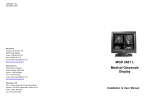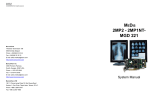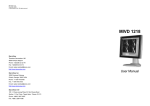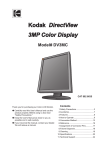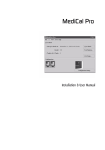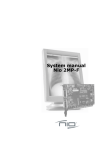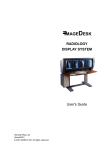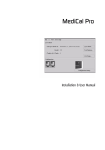Download Barco MGD 521 MKII Personal Lift User Manual
Transcript
V599326/Rev. 02 June 2003 BarcoView Theodoor Sevenslaan 106 8500 Kortrijk, Belgium Phone: +32(0)56 23 32 44 Fax: +32(0)56 23 33 74 E-mail: [email protected] http://www.barcoview.com BarcoView Inc 3059 Premiere Parkway Duluth, Georgia, 30097,USA Phone: +1 678 475 8000 Fax: +1 678 475 8100 MGD 521 M MGD 521 MKII Medical Greyscale Displays E-mail: [email protected] http://www.barcoview.com BarcoView LTD 16F-1, Cheng Loong Plaza 33, Min Sheng Road Section 1, Pan Chiao, Taipei Hsien, Taiwan, R.O.C. Phone: +886 2 2957 8357 Fax: +886 2 2957 4080 Installation & User Manual © 2003 BARCO nv. All rights reserved. Trademark information TrueGrey, MediCal, BarcoMed, and MeDis are registered trademarks of BARCO NV. Windows NT is a registered trademark of Microsoft Corporation. MGD 521 M - MKII User's Guide 3 MGD 521 M - MKII User's Guide 4 SAFETY INSTRUCTIONS Read the safety and operating instructions before operating the apparatus. Retain safety and operating instructions for future reference. Adhere to all warnings on the apparatus and in the operating instructions manual. Follow all instructions for operation and use. Regulations This apparatus conforms to: IEC601-1, UL2601-1, cUL2601-1, EN 60601-1 This apparatus is classified as Type B without Applied Part. Usage in Hazardous locations Class I equipment Equipment not suitable for use in the presence of a flammable anaesthetic mixture with air or with oxygen or nitrous oxyde. FCC notice This equipment has been tested and found to comply with the limits of a class A digital device, pursuant to Part 15 of the FCC rules. These limits are designed to provide reasonable protection against harmful interference when the equipment is operated in a commercial environment. This equipment generates, uses and can radiate radio frequency energy and, if not installed and used in accordance with the instruction manual, may cause harmful interference to radio communications. Operation of this equipment in a residential area is likely to cause harmful interference in which case the user will be required to correct the interference at his own expense. ! Power connection Power cord: Utilise a UL-listed detachable power cord, 3-wire, type SJ or equivalent, 18 AWG min., rated 300 V min., provided with a hospital-grade type plug 5-15P configuration for 120V application, or 6-15P for 240V application. Warning: This apparatus must be earthed! Power requirements: connect the apparatus to an AC voltage as indicated at its back. Using a lower voltage, the apparatus will not be able to operate. Using a higher voltage may damage the apparatus. If you are not sure of the type of power supplied, consult the power company. Do not overload wall outlets and extension cords as this may result in fire or electric shock. Mains lead protection (U.S.: Power cord): Supply cords should be routed so that they are not likely to be walked upon or pinched by items placed upon or against them, paying particular attention to cords at plugs and receptacles. Water and moisture Never expose the apparatus to rain or moisture. Never use the apparatus near water - e.g. near a bathtub, washbasin, swimming pool, kitchen sink, laundry tub or in a wet basement. Ventilation Do not cover or block the ventilation openings in the cover of the set. When installing the apparatus in a cupboard or another closed location, heed the necessary space between the set and the sides of the cupboard. Installation Place the apparatus on a flat, solid and stable surface that can bear the weight of at least 3 monitors. If you use an unstable cart or stand, the set may fall, causing serious injury to a child or adult, and serious damage to the equipment. More warnings in the Installation chapter. MGD 521 M - MKII User's Guide 5 MGD 521 M - MKII User's Guide 6 CONTENTS 1. Introduction ..................................................................................................... 9 1.1 Overview .................................................................................................. 9 Resolution and bandwidths ....................................................................... 9 The memory system .................................................................................. 9 Image conformity and consistency ............................................................ 9 Calibration and adjustments ...................................................................... 9 Power saving system ............................................................................... 10 1.2 Versions and options .............................................................................. 10 1.3 About the manuals ................................................................................. 11 2. Installation ..................................................................................................... 12 2.1 Precautions ............................................................................................ 12 2.2 The package contents ............................................................................ 12 2.3 Controls and connectors ........................................................................ 13 2.4 Signal connection ................................................................................... 14 a) Connection of video signals ................................................................ 14 b) Connection of data signals .................................................................. 15 c) Connection of optical sensor ............................................................... 15 d) Connection of power ............................................................................ 16 2.5 Positioning the display ........................................................................... 16 Important considerations .............................................................................. 17 3. Operation: User controls ............................................................................... 18 3.1 Switching on / off .................................................................................... 18 3.2 Contrast and brightness control ............................................................. 19 3.3 Viewing Status information ..................................................................... 21 3.4 Other adjustments .................................................................................. 22 4. Advanced settings and Adjustments (For service staff only) ........................ 23 4.1 Settings .................................................................................................. 23 4.2 Adjustments ............................................................................................ 25 a) How to make the adjustments ............................................................. 25 b) Description of the adjustments ............................................................ 25 Geometry ......................................................................................... 25 Focus ............................................................................................... 31 ALC (optional) .................................................................................. 31 Luminance uniformity ....................................................................... 32 Factory reset .................................................................................... 32 c) How to save changes .......................................................................... 32 5. Maintenance ................................................................................................. 33 6. Troubleshooting ............................................................................................ 34 Appendix A: Background information ............................................................... 35 Appendix B: Technical specifications ............................................................... 37 MGD 521 M - MKII User's Guide 7 MGD 521 M - MKII User's Guide 8 1. INTRODUCTION 1.1 Overview Resolution and bandwidths The BARCO MGD 521 M and MGD 521 MKII displays are ultra-high resolution, grayscale portrait displays. Their outstanding visual performance, combining a 5 MegaPixel resolution with a very high brightness, makes them ideal for diagnostic imaging and many other medical and scientific applications. The displays are compatible with any AC power system worldwide and automatically synchronise to a wide range of sync frequencies. their high-speed video amplifiers support pixel clocks up to 500 MHz (MGD 521 M: 550 MHz). The memory system The internal memory system can contain the adjustments for 16 different scanning formats, the so-called scanning modes. Each scanning format is characterized by its sync signals. The displays internal micro controller continuously samples the connected sync signals and compares them to the scanning modes already stored in the memory. If the connected signal has already been stored, the micro controller adapts the image to the corresponding adjustment values in the memory, and further adjustments are unnecessary. Image conformity and consistency Image conformity and consistency are the keywords. In our factory, the MGD 521 displays are perfectly adjusted and calibrated before they are shipped to the customer. Internal circuits, like the TrueGrey® and Automatic White Stability (AWS) systems, ensure display consistency over time. Conformity with the original image quality is guaranteed by the automatic calibration, which can be done by means of an optical sensor, connected to the Sensor connector on the display. The sensor is not supplied with the display. Calibration and adjustments The conformity calibration, as well as the complete adjustment of the display, can be performed by means of the remote, user-friendly MediCal® software package. MediCal is especially developed to Introduction 9 adjust and check BARCOs medical displays. A lot of adjustments can also be done on the monitor itself, by means of an extensive on-screen menu system, accessible from the rear panel controls. Power saving system The MGD 521 displays are equipped with a power saving system. When left idle for a certain time, the computer, connected to the display, will power down the display in several steps. The power saving system can be switched on or off during the installation or adjustment of the display. This system requires a computer imaging board that supports power saving management. 1.2 Versions and options MGD 521 M MGD 521 MKII P45 phosphors ................ x .................................. x P104 phosphors .................................................... x 50 Ohm input .................. x .................................. x 75 Ohm input .................. x .................................. x Notes: - The P45 phosphors produce rather bluish images, whereas the P104 phosphors produce more yellowish images. - A video input terminated to 50 Ohm requires an imaging board with an impedance of 50 Ohm. A video input terminated to 75 Ohm requires an imaging board with an impedance of 75 Ohm. - The type of CRT phosphors and the video input termination are indicated on the label at the rear of the display. Important: It is absolutely necessary that the impedances of imaging board and display are the same. If not, the image quality will be inferior. The MediCal software and the X-Rite DTP92 sensor are not delivered with the display. MediCal can be ordered separately. Introduction 10 1.3 About the manuals This guide is meant for people who want to install and use the MGD 521 displays, as well as people who need to install and adjust the displays. Chapter 4, Adjustments, is meant for this second category only, because it describes actions and procedures that require a technical skill to be performed properly. The use of the software MediCal is described in the MediCal Users Manual. Installation 11 2. INSTALLATION 2.1 Precautions Keep your original packaging. It is designed for this display and is the ideal protection during transport. Do not lift the display all by yourself to avoid injury. Avoid reflections in the picture tube to reduce eye strain. Place the display on a strong and stable table or desk if used as desktop display. Keep the display away from heat sources and provide enough ventilation in case it is built in a rack or console. Keep the display away from strong sources of magnetic fields. Make sure the display and computer are both switched off before connecting the signals. 2.2 The package contents The display The accessory box (in which you found this manual) Notes: The display can be part of a complete MeDis® system, consisting of the display itself, an imaging board and software. In that case, the package contains a lot more items. The contents of the package is then described in the manual of the complete system. The ambient light shield inside the accessory box should always be used during conformity calibration with the X-Rite DTP92 optical sensor. Installation 12 2.3 Controls and connectors {1} Optical sensor plug {2} Ambient Light Compensation (ALC) sensor (optional) {3} Green power LED {4} Control knob, combination of a push button and a turning knob. The control knob is used for switching the power on/off, and selecting and performing functions in the OSD (onscreen display) menu. {5} Remote (RS-232) output {6} Remote (RS-232) input {7} Video input 5 6 7 8 9 {8} Horizontal / composite sync. input {9} Vertical sync. input 10 11 {11} Power button 3 2 1 4 REMOTE OUT REMOTE IN VIDEO HS / CS VS {10} Power input Installation 13 2.4 Signal connection a) Connection of video signals ! The connected equipment must comply to all relevant safety demands. Important: The use of low-quality video cables can distort the video signal and influence diagnosis. 1. Check the impedance of the imaging board that produces the video signals you want to connect. It must be 50 or 75 Ohm (just like the input of the display). If not, the quality of the images on the display will be inferior. 2. Connect the video output of the computers imaging board to the video and sync inputs on the displays rear panel. Use a proper video cable. The video cable is not supplied with the display, unless the display comes as part of a complete BARCO MeDis system, that also contains an imaging board. The inputs accept the following signals: Video with separate horizontal and vertical sync. - The video cable has 3 wires. - Connect the video signal to the connector Video {7}. - Connect the horizontal sync signal to the connector HS/CS {8}. - Connect the vertical sync signal to the connector VS {9}. Video with external composite sync. - The video cable has 2 wires. - Connect the video signal to the connector Video {7}. - Connect the composite sync signal to the connector HS/CS {8}. Video with internal composite sync (sync on video). - The video cable has 1 wire. - Connect the video (with sync) signal to the connector Video {7}. - The vertical sync pulse must be at least 2 lines long. Notes: The video inputs cannot be connected in loop-through (daisychain). The required video amplitude: 700 mV. The required sync. amplitude: 500 mV. Installation 14 b) Connection of data signals The display can be controlled remotely by a computer through the serial data bus. A typical example of this, is the MediCal software that controls the display. MediCal runs on a PC that is connected through the serial data bus. This PC is not necessarily the same computer as the one that produces the video signals. Unlike the video signals, it is possible to daisy-chain the serial data bus. This means you can control different displays from one PC. To connect the data signals: 1. Connect one end of the serial data cable to one of the PCs COM ports. If the COM port has a 25-pin connector, you will need to use a D25-to-D9 interface connector. The cable and the interface connector are both supplied with MediCal. 2. Connect the other end of the serial data cable to the Remote In connector {6} on the displays rear panel. 3. For a daisy-chain application, connect the Remote Out connector {5} of the first display to the Remote In connector {6} of the next display. c) Connection of optical sensor To calibrate the display, connect the optical sensor to the Sensor connector {1} at the front. Notes: The display supports the DTP 92 from X-Rite as optical sensor. The optical sensor is not supplied by BARCO. Calibration can be done by means of MediCal only. Always use the Ambient Light Shield during calibration. 1 At the front, the sensor plug is located under the bezel. Installation 15 d) Connection of power 1. Power cord: Utilize a UL-listed detachable power cord, 3-wire, type SJ or equivalent, 18 AWG min., rated 300 V min., provided with a hospital-grade type plug 5-15P configuration for 120V application, or 6-15P for 240V application. 2. Plug one end of the power cord into the rear of the display (connector LINE {10}). Plug the other end into a grounded AC power outlet. The display automatically adapts to the voltage. The voltage range is: 100-240 VAC +/- 10%. 2.5 Positioning the display The tilt and swivel base allows you to adjust the height and viewing angle of the display to obtain an optimal viewing comfort. Installation 16 Important considerations The best environment for diagnostic imaging is one with controlled and dimmed ambient light. The human eye's sensitivity depends on the ambient light strength. It is most sensitive to small contrast changes (or subtle image details) at limited ambient light levels. The best ambient light level, expressed in Lux, depends on the application. An office illumination typically requires 500 Lux. A dimmed environment, like a softcopy room, requires less than 100 Lux. Using your display in a controlled and dimmed environment also extends its lifetime, because the display can operate at limited brightness and contrast. These levels correspond to the calibrated position in most cases. A controlled ambient light environment implies the ambient light is as constant as possible. Cover windows to keep out the daylight. Avoid switching the lights and viewing boxes on and off. A consistent environment results in more image consistency and less eye fatigue. Avoid reflections in the picture tube. Provide indirect lighting. Don't place the displays in front of or close to a light source like a window or viewing box, although this may be very tempting. As a rule of thumb, keep viewing boxes at least one metre (3 feet) away from the displays. Installation 17 3. OPERATION: USER CONTROLS Important: The best way to adjust and control the display is by using MediCal, which displays the ideal test patterns for correct adjustment. However, in case you do not dispose of MediCal, you can control and adjust the display by means of the built-in On-Screen Display (OSD). 3.1 Switching on / off Power on/off Press the Power button {11} on the rear panel to switch on the display. The green LED at the front is off when the display is operating. If the display starts up with no image and the green LED {3} on, it is in stand-by. This is the case when the display was powered down while in stand-by. Manual stand-by To put the display in manual stand-by mode, press the control knob {4} shortly. As a result, the green LED is ON continuously. Note: You cannot switch the display in manual stand-by when the onscreen display (OSD) is visible. In that case, first exit the OSD, and then press the control knob to switch to stand-by mode. To activate the display from stand-by mode, press the control knob {4} again. As a result, the LED is switched off again. Automatic power saving system (DPMS) The power saving system, if switched on, can power down the display when you don't use the computer that produces the video and sync. signals for a while. In that way, the system reduces the display's power consumption. While the display is powered down, the picture tube will be blanked, and the green LED on the front is on. The power saving system is switched off when the display is produced. It can be switched on by a qualified technician. Note: The power saving system can only work if the connected imaging board supports power management. For more details, please read Appendix A, "Background information". Operation 18 3.2 Contrast and brightness control Contrast and brightness can be controlled through the OSD menus. To activate the OSD Turn the control knob {4} from left to right or from right to left. As a result, the OSD main menu appears. Note: The control knob should turn over at least 30 degrees before the OSD becomes visible. MAIN MENU - Contrast CAL Brightness CAL Status information Settings Adjustments Exit The OSD main menu The main menu indicates the current setting for contrast and brightness. This can be: CAL: The calibrated position. This is the preferred setting in a controlled environment. ALC: This indicates the Ambient Light Compensation (ALC) is on, and contrast and brightness are controlled automatically, depending on the ambient light. ALC is an option. <empty> When the main menu does not specify a setting, contrast or brightness is manually set to a different value than the calibrated position. To put contrast in calibrated position 1 Turn the control knob to select Contrast in the OSD main menu. 2 Press the control knob shortly. The contrast control menu appears. 3 In the contrast control menu, select Contrast CAL position and press the control knob shortly. Contrast - Contrast CAL position - Manual contrast adjustment - Exit Contrast control menu Operation 19 To control contrast manually 1 Turn the control knob to select Contrast in the OSD main menu. 2 Press the control knob shortly. The contrast control menu appears. 3 In the contrast control menu, select Manual contrast adjustment and press the control knob shortly. The contrast scroll bar appears. 4 Turn the control knob until you have reached the desired contrast. 5 Press the control knob shortly or wait a few seconds to return to the contrast control menu. 6 In the contrast control menu, select Exit and press the control knob shortly to return to the main menu. Alternatively, you can just wait a few seconds, and the OSD returns to the previous menu automatically. Contrast Contrast scroll bar. The short stroke in the bar indicates the calibrated position, the long stroke indicates the current setting. To put brightness in calibrated position 1 Turn the control knob to select Brightness in the OSD main menu. 2 Press the control knob shortly. The brightness control menu appears. 3 In the brightness control menu, select Brightness CAL position and press the control knob shortly. Brightness - Brightness CAL position - Manual Brightness adjustment - Exit Brightness control menu To control brightness manually 1 Turn the control knob to select Brightness in the OSD main menu. 2 Press the control knob shortly. The brightness control menu appears. 3 In the brightness control menu, select Manual brightness adjustment and press the control knob shortly. The brightness scroll bar appears. Brightness Brightness scroll bar. The short stroke in the bar indicates the calibrated position, the long stroke indicates the current setting. Operation 20 4 Turn the control knob until you have reached the desired brightness. 5 Press the control knob shortly or wait a few seconds to return to the brightness control menu. 6 In the brightness control menu, select Exit and press the control knob shortly to return to the main menu. Alternatively, you can just wait a few seconds, and the OSD returns to the previous menu automatically. 3.3 Viewing Status information You can view the status and actual settings of the display. You cannot change them in the Status Menu. Changing the settings is reserved for trained service staff only. To view the status information Turn the control knob to select Status information in the OSD main menu. The Status information menu appears. The only control in the menu is Exit. STATUS INFORMATION Display Name: MGD 521MKII Serial Number: 5114147 Mode Name: New mode Mode H-frequency: 175.32 kHz Mode V-frequency: 79.94 Hz Software Version: V 1.01 Run time: 50 hours White level: 300 cd/m2 Activity timeout 30s SH compensation OFF Actual H-frequency:125.30kHz Actual V-frequency: 80.00 Hz - Exit Example of Status information menu for MGD 521 MKII displays Explanation of the Status information menu items Display Name: This is the display type. Serial Number: This is the display's serial number. Mode Name: The currently selected scanning mode. Mode H-frequency, Mode V-frequency: These are the horizontal and vertical sync frequencies of the currently selected scanning mode. These are the figures stored in the memory. Operation 21 Software Version: The internal software version. Run time: The total operating time since production, including burn-in time. White level: The displays white level or light output after calibration, in calibrated position. Activity timeout : This is the time, expressed in seconds, before the display interrupts the data communication with the computer (e.g. during a computer session with MediCal) if the computer does not respond anymore. SH compensation (optional): Indicates if Southern Hemisphere compensation is switched on or off. Note: Southern Hemisphere compensation is an option. If the option is not installed in the display, this line does not appear in the menu. Actual H-frequency, Actual V-frequency: These are the actual horizontal and vertical sync frequencies of the connected video signal. They are measured constantly by the display. 3.4 Other adjustments The main menu items Settings and Adjustments are reserved for trained service staff and are therefore password - protected. Operation 22 4. ADVANCED SETTINGS AND ADJUSTMENTS (FOR SERVICE STAFF ONLY) Important: The functions and controls described in this chapter can have a serious impact on the performance of the display. They should be touched by trained service staff only! 4.1 Settings SETTINGS INFORMATION - LUC ALC Orbiter Power save Display address User controls disable Exit OFF OFF OFF ON 1 OFF The Settings menu To change the settings 1 Turn the control knob at the rear from left to right or from right to left to activate the On-Screen Display (OSD) main menu. 2 In the main menu, turn the control knob to select Settings. 3 Press and hold the control knob for a few seconds. The Settings menu appears. It displays each setting and its current status. Note: If you press only shortly, the message "Service protected" appears. 4 Turn the control knob to select the setting you want to change. 5 Press the control knob shortly to change the selected setting. 6 For Display address, you can change the setting by turning the control knob. Return to the Settings menu by pressing the control knob. For the other settings, the new status instantly appears in the Settings menu. Advanced 23 Explanation of the Settings menu items LUC: LUC is short for Luminance Uniformity Control. When switched on, the internal waveform processor will modulate the gain of the video amplifier so that the luminance is equal all over the screen (within a tolerance of +/- 5%). The LUC system can be calibrated in the Adjustments menu (see further). ALC (optional): ALC is short for Ambient Light Compensation. When this setting is on, the contrast is controlled automatically, depending on the ambient light, measured by the ALC sensor {2} in the bezel. Orbiter: The Orbiter is an internal circuit that, when switched on, will slightly and slowly move the image to prevent pixel burn-in. Power save: This setting can switch the automatic power saving system (see Introduction chapter) on or off. Display address: In multi-head systems (multiple displays controlled by one system), each display must have a different address. With this setting you can set the display address from 1 to 16. User controls disable: With this setting you can enable or disable the user controls. When OFF, the user controls are not disabled, and the user can activate and use the OSD menus. When ON, the user controls are disabled. After quitting the OSD, the user will no longer be able to activate the OSD. To activate the OSD again when the user controls are disabled, use the following "code": 1 Turn the control knob 3 times counter-clockwise (seen from the rear). 2 Turn the control knob 3 times clockwise. 3 Turn the control knob 3 times counter-clockwise. Note: This should be done in quite a short time! Saving the settings The settings are automatically saved after changing them. Advanced 24 4.2 Adjustments a) How to make the adjustments 1 Turn the control knob at the rear from left to right or from right to left to activate the On-Screen Display (OSD) main menu. 2 In the main menu, turn the control knob to select Adjustments. 3 Press the control knob for a few seconds. The Adjustments menu appears. Note: If you press only shortly, the message "Service protected" appears. 4 Turn the control knob to select the category of adjustments you want to make. 5 Press the control knob shortly to enter the selected category. 6 In the selected menu, select the adjustment you want to make and press the control knob shortly to display the adjustment scroll bar. 7 Turn the control knob to perform the adjustment. After adjusting, press the knob shortly to confirm the adjustment and return to the menu, or press for a longer time to undo the adjustment and return to the menu. 8 Return to the previous menu by pressing the control knob shortly or selecting Exit when present. b) Description of the adjustments ADJUSTMENTS - Geometry Focus ALC Luminance uniformity Factory reset Exit Adjustments menu Geometry Rotation Advanced 25 Width Horizontal position Height Vertical position Blanking - Blanking left Blanking - Blanking right Blanking - Blanking top Advanced 26 Interlacing - Pre correction In most cases you do not need to change this adjustment. You may need to increase this adjustment only when the connected video and sync signal contains an abnormally big number of equalization pulses before the vertical sync (more than 8 lines), resulting in a phase error (geometry distortion) at the bottom of the image. Interlacing - Post correction In most cases you do not need to change this adjustment. You may need to increase this adjustment only when the connected video and sync signal contains an abnormally big number of equalization pulses after the vertical sync (more than 8 lines), resulting in a phase error (geometry distortion) at the top of the image. SH Compensation (optional) If your display is equipped with the Southern Hemisphere option, the on-screen display menu contains additional functions to adjust the image geometry. If the option is not installed in the display, this menu does not appear. SH Compensation - SH Compensation ON/OFF For proper geometry adjustment in the Southern Hemisphere, you must switch SH Compensation ON. If not, the SH controls will not function. SH Compensation: SH Top SH Compensation: SH Bottom Advanced 27 SH Compensation: SH Position With SH Compensation on, we advise to use the SH Position control instead of the Horizontal Position control in the Geometry menu. Advanced geometry - Horizontal skewing Advanced geometry - Horizontal bowing Advanced geometry - Horizontal trapezium Advanced geometry - Horizontal parabola Advanced geometry - Corner top left Advanced 28 Advanced geometry - Corner top right Advanced geometry - Corner bottom left Advanced geometry - Corner bottom right Advanced geometry - Linearity & S-correction Horizontal linearity Advanced geometry - Linearity & S-correction Horizontal S-corr Advanced geometry - Linearity & S-correction Vertical linearity Advanced 29 Advanced geometry - Linearity & S-correction Vertical S-corr Advanced geometry - Advanced bowing & skewing Horizontal bowing left Advanced geometry - Advanced bowing & skewing Horizontal bowing right Advanced geometry - Advanced bowing & skewing Horizontal skewing left Advanced geometry - Advanced bowing & skewing Horizontal skewing right Advanced 30 Focus Static focus Adjust Static focus to obtain an image as sharp as possible in the center. Focus zone You can adjust the focus in 25 independent zones. Turn the control knob to obtain an image as sharp as possible in the selected zone. Press the control knob to switch to the next zone. ALC (optional) Ambient Light Compensation (ALC) is an optional system that automatically adapts the display contrast and brightness level to the ambient light in the room. The system has to be adjusted by setting the contrast and brightness in the darkest ambient light conditions the user works, and then repeating this in the brightest conditions. To adjust the ALC system, proceed as follows: 1. Dim the light in the room to create the darkest ambient light condition the user normally works in. 2. Enter the Minimum illuminance menu. 3. Select Measure ambient light. The display now stores the ambient light level that corresponds to the darkest condition. 4. Select Contrast and set the display contrast to the desired level. 5. Select Brightness and set the display brightness to the desired level. 6. Exit the Minimum illuminance menu. 7. Increase the light in the room to create the brightest ambient light condition the user normally works in. 8. Enter the Maximum illuminance menu. 9. Select Measure ambient light. The display now stores the ambient light level that corresponds to the brightest condition. 10. Select Contrast and set the display contrast to the desired level. 11. Select Brightness and set the display brightness to the desired level. 12. Exit the Maximum illuminance menu. Advanced 31 Luminance uniformity This menu allows you to calibrate the display, including the Luminance Uniformity circuit. Proceed as follows: 1 Connect the X-Rite DTP92 sensor and apply the black shield (see chapter "Installation"). 2 Follow the instructions on the screen. Factory reset This function allows you to undo all adjustments you have made since the display left the factory. Select Go ahead to restore the factory settings. Select Exit to return to the previous menu without erasing the adjustments. c) How to save changes Proceed as follows: 1 After having made the adjustments, select Exit in each appearing menu until the Save Changes? message appears. 2 Select Yes to save the changes. Select No to exit the OSD menus without saving the changes. What happens upon saving? When the current scanning mode was already stored in the display memory, the scanning mode is updated with the new adjustment values. When the scanning mode was not yet stored in the memory, the display will create a new scanning mode in the memory. However, when the memory was full, the monitor will display a list of scanning modes in the memory and ask if you wish to overwrite one of them. If you want to store the adjustments you have made, you will have to overwrite one of the scanning modes in memory. Advanced 32 5. MAINTENANCE Picture tube The glass panel of the picture tube is handled with a special coating. Take care not to damage or scratch the coating. Clean the picture tube with a soft woolen or cotton cloth. The cloth should be moist, not wet! Use a watery solution or a mild commercial glass cleaning solution. Apply (e.g., spray) the solution on the cloth, not on the picture tube. Cabinet Clean the cabinet using a recognized cleaning product for medical equipment. The cloth you use must be moist, not wet! The cabinet has been tested for resistance to the following products: Cidex, Betadine, Alcohol (Isopropyl and Ethyl), Ammonia-based cleaners (Windex) and Aquasonic Gel. Maintenance 33 6. TROUBLESHOOTING There appears no image on the picture tube, the green LED at the front is out Check if the power cord is properly connected to the power outlet and to the display. Check if the power button is switched on. There appears no image, the green LED is on The display is switched in Stand-by, manually or by the automatic Power saving system. Press the control knob at the rear shortly. Try to switch on the display by pressing any key on the keyboard of the computer that produces the video and sync. signals for the display. Check if both horizontal and vertical sync. signals are connected to the display and to the computer. On the picture tube appears the message "No Valid Sync Signal" Check if both horizontal and vertical sync. signals are connected to the display and to the computer. Check if the sync. signals are connected in the proper way (refer to the chapter "Installation"). Check if both horizontal and vertical sync. frequencies match the display specifications (refer to the chapter "Technical specifications"). For other problems, please consult your technical service department. Troubleshooting 34 APPENDIX A: BACKGROUND INFORMATION Luminance Uniformity Correction A characteristic (or limitation) of every picture tube (CRT) is that the luminance decreases towards the edge of the screen surface. The decrease is normally 20 to 30 %. This is caused by the shape of the picture tube. Inside the CRT, a socalled electron gun shoots an electron beam towards the front (the glass panel). Because this panel is rather flat instead of having a spheric shape, the electron beam has to 'travel' a longer distance in the corners than in the center. So the intensity is higher in the center. This phenomenon is even increased by the irregular distribution of the phosphor and aluminium layer on the glass panel. These tend to be thicker in the center. BARCO has developed a special system, called Luminance Uniformity Correction (LUC), that solves this problem. The LUC system enhances the light output at the edges of the CRT, so that the luminance there is the same as in the center. The LUC system is calibrated in the factory. From time to time, it has to be re-calibrated at the customer's site by means of the light sensor you use for normal color calibration. The system can be calibrated and switched on or off by a qualified technician. Power saving system The display is equipped with circuits that can handle power saving management. When the system is switched on, it can power down the display in several steps. The system is controlled by the imaging board or the PC that delivers the video signals. When you are working on the computer, the imaging board delivers both sync signals, and the display is operating normally. When you don't touch the computer keyboard for a certain time, the imaging board only delivers vertical sync. This is sensed by the display's micro controller, that blanks the image on the CRT. This results in a drop of power consumption with about 25 %. When you leave the computer idle for a longer period, the imaging board now delivers horizontal sync only. As a result, the display's micro controller switches off a number of internal circuits. The power consumption has now dropped with about 42 %. Background information 35 At last, the imaging board delivers no sync signals at all, and the micro-controller switches off all but one power supplies in the display. Only the micro-controller's own supply keeps on running, resulting in a very low power consumption of 5 W. If you start using the computer again, the imaging board switches on both sync signals, and the micro-controller switches on the display. The times after which the different steps of power management must become active, is set in the PC's display properties. Background information 36 APPENDIX B: TECHNICAL SPECIFICATIONS Picture tube: Faceplate transmission: +/- 32% Faceplate type: ARC panel Image representation: portrait Phosphor: P45 (standard) or P104 (option for MGD 521 MKII only) Light output: (P45 phosphor) MGD 521: Calibrated: 300 Cd/m2 MGD 521M: Calibrated: 400 Cd/m2 Peak: 600 Cd/m2 Resolution: Max. adress. pixels: 2048 Max. adress. lines: 2560 Scanning systems Horizontal scanning: Multi sync: µ-controller controlled Minimum frequency: 160 kHz Maximum frequency: 200 kHz Minimum blanking : 1.28 µs Storable scan frequencies: 16 Prealigned scans: 1 or 2 Vertical scanning: Minimum frequency: 48 Hz Maximum frequency: 150 Hz Minimum blanking: 250 µs (after leading edge) Geometry Nominal size (4/3 ratio): 300mm x 400mm Nominal size (4/5 ratio): 304mm x 380mm Power supply: Voltage: 100 - 240 V +/- 10% Frequency: 50/60 Hz Current: 2.3 A Environmental Temperature range (°C): Storage: -20/+65 Operation: 0/+45 Within specs: 15/+30 Altitude: storage: 25 000 ft operational: 10 000 ft Humidity (relative): 95 % max., non condensing Weight: UnpackedPacked 39.8 kg 58.3 kg Dimensions packing: H x W x D: 788mm x 630mm x 780mm Dimensions monitor (mm): Height: 558 Width: 400 Depth: 561 Modifications reserved. Inputs Video BNC connectors Nominal level: 0.7 Vpp Sync BNC connectors Nominal level: 0.5 Vpp Communication inputs/outputs RS232 9-pin sub D connector Baudrate: 9600 Technical specifications 37






































